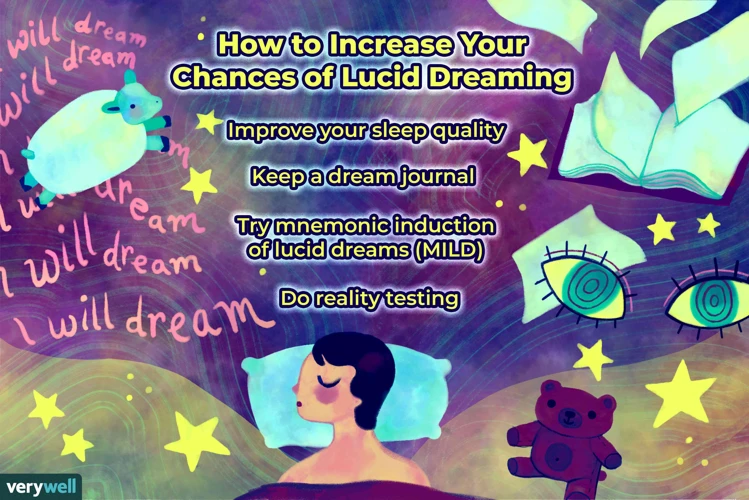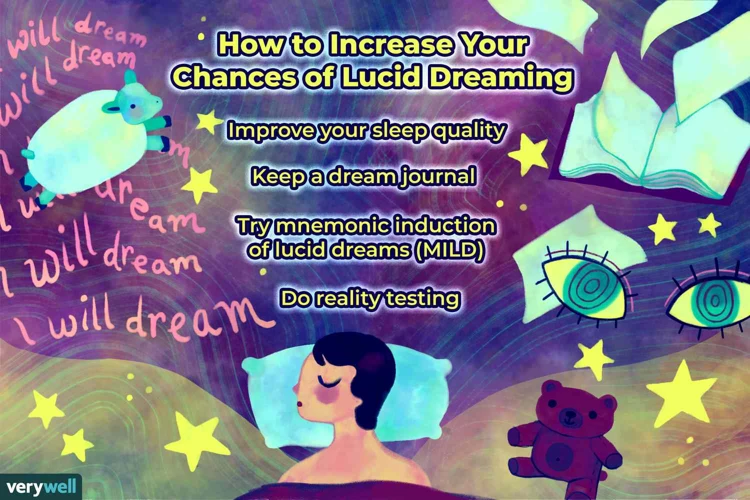For many individuals, sleep can be a battleground, plagued by nightmares and sleep disorders that disrupt a restful night’s rest. However, there is a fascinating phenomenon called lucid dreaming that holds promise for managing nightmares and overcoming sleep disorders. Lucid dreaming allows individuals to be aware that they are dreaming, giving them the power to control the content and direction of their dreams. In this comprehensive guide, we will delve into the role of lucid dreaming in nightmare management and sleep disorder treatment, exploring its benefits, techniques to induce lucid dreaming, and tips for enhancing dream experiences. So, if you’re ready to unlock the potential of your dreams and finally conquer those nighttime demons, read on to discover how lucid dreaming can be your secret weapon in the battle for a good night’s sleep.
Understanding Nightmares

Nightmares can turn a peaceful sleep into a terrifying experience, leaving individuals feeling scared and shaken. Nightmares are vivid, disturbing dreams that evoke intense emotions, such as fear, anxiety, or helplessness. They can often involve threatening situations, recurring themes, or traumatic events. Common causes of nightmares include stress, trauma, medication, sleep deprivation, and certain medical conditions. Nightmares can have a significant impact on sleep disorders, as they often lead to disrupted sleep patterns and insomnia. Understanding the underlying causes and effects of nightmares is essential in finding effective strategies to manage and overcome them. By addressing these issues, individuals can take back control of their sleep and experience peaceful nights free from the horrors of nightmares. (Source: /understanding-benefits-risks-lucid-dreaming/)
Definition of Nightmares
Nightmares are intense and distressing dreams that can leave individuals feeling frightened, anxious, and disturbed upon waking up. They are characterized by vivid and detailed content that often involves threatening situations, danger, or a sense of helplessness. Nightmares can cause a surge of emotional reactions, such as fear, panic, or sadness, which can linger long after waking up. These dreams are different from regular dreams in that they elicit strong negative emotions and can be highly realistic in nature. Nightmares can vary in theme and content, ranging from being chased or attacked, experiencing the loss of a loved one, or reliving traumatic events. They often disrupt sleep and can lead to difficulty falling back asleep, resulting in a decreased quality of rest. Understanding the definition of nightmares is the first step in recognizing and addressing their impact on sleep and overall well-being. (Source: /exploring-lucid-dreaming/)
Causes of Nightmares
Nightmares can stem from a variety of causes, ranging from everyday stressors to underlying medical conditions. Understanding the causes of nightmares is crucial in effectively managing and addressing these distressing dreams.
Stress and Anxiety: High levels of stress, anxiety, and emotional turmoil can contribute to nightmares. When the mind is overwhelmed with worry, fear, or unresolved emotions, it may manifest in dreams as distressing scenarios.
Trauma and PTSD: Individuals who have experienced traumatic events, such as accidents, abuse, or combat, may suffer from nightmares as a symptom of post-traumatic stress disorder (PTSD). These nightmares often recur, reliving the traumatic event and causing significant distress.
Medications: Certain medications, such as antidepressants, beta-blockers, and some sleep aids, have been known to induce nightmares as a side effect. It is important to discuss any medication-related concerns with a healthcare professional.
Substance Abuse: Substance abuse, including alcohol and recreational drugs, can disrupt sleep patterns and contribute to nightmares. These substances can interfere with the brain’s normal sleep processes, leading to vivid and disturbing dreams.
Sleep Disorders: Sleep disorders such as sleep apnea, restless legs syndrome, and narcolepsy can increase the likelihood of nightmares. Disruptions in sleep patterns and abnormalities in sleep cycles can influence dream content and intensity.
Underlying Mental Health Conditions: Mental health conditions, including depression and anxiety disorders, have been linked to an increased prevalence of nightmares. It is important to address and manage these conditions to help alleviate nightmare frequency.
By identifying and addressing the specific causes of nightmares, individuals can take steps towards finding relief and improving the quality of their sleep. (Source: /lucid-dreaming-personal-growth/)
Impact on Sleep Disorders
Nightmares have a profound impact on sleep disorders, exacerbating existing conditions and creating new ones. One of the most common sleep disorders affected by nightmares is insomnia. The intense fear and anxiety experienced during nightmares can lead to difficulty falling asleep, frequent awakenings during the night, and overall poor sleep quality. Nightmares can also contribute to the development or worsening of sleep apnea, a condition characterized by pauses in breathing during sleep. The emotional arousal triggered by nightmares can cause disruptions in breathing patterns, leading to more frequent apnea events. Additionally, nightmares can have a negative impact on individuals with narcolepsy, a neurological disorder characterized by excessive daytime sleepiness. The disturbing and disruptive nature of nightmares can further disrupt the already fragmented sleep patterns experienced by individuals with narcolepsy. It becomes crucial to address and manage nightmares in order to improve sleep quality and alleviate the symptoms of various sleep disorders.
Lucid Dreaming Explained

Lucid dreaming is a phenomenon where individuals become aware that they are dreaming while still in the dream state. Unlike regular dreams, where the dreamer is passively experiencing the events, in a lucid dream, the dreamer has a sense of self-awareness and can actively participate in and influence the dream’s content and direction. Lucid dreaming occurs during REM (Rapid Eye Movement) sleep, the stage of sleep when most dreaming takes place. During lucid dreaming, the dreamer can engage in activities they may not otherwise be able to do in reality, such as flying, meeting fictional characters, or exploring surreal landscapes. This extraordinary state of consciousness offers a unique platform for creativity, personal growth, and self-exploration. By harnessing the power of lucid dreaming, individuals can tap into their subconscious mind, gain insight into their emotions and desires, and even practice real-life skills within the dream world. (Source: /exploring-lucid-dreaming/)
Definition of Lucid Dreaming
Lucid dreaming is a fascinating phenomenon where individuals become aware that they are dreaming while still in the midst of the dream itself. This heightened state of consciousness allows dreamers to have a sense of control and agency within their dreams. During a lucid dream, individuals are able to recognize that the events and surroundings they are experiencing are not part of their waking reality. They may also have the ability to manipulate the dream environment, alter the storyline of the dream, or interact with dream characters. Lucid dreaming is often characterized by a feeling of clarity and realism, allowing individuals to engage and participate in their dreams in a deliberate and intentional manner. This phenomenon has captured the interest of researchers and dream enthusiasts alike, as it opens up a world of possibilities for self-exploration, creativity, and personal growth. (Source: /exploring-lucid-dreaming/)
How Lucid Dreaming Works
How Lucid Dreaming Works:
1. Increased Self-Awareness: Lucid dreaming occurs when an individual becomes aware that they are dreaming while still in the dream state. This heightened level of self-awareness allows dreamers to recognize the often fantastical and unrealistic nature of their dreams.
2. Activation of the Prefrontal Cortex: The prefrontal cortex, the part of the brain responsible for logic, decision-making, and self-awareness, plays a crucial role in lucid dreaming. During a lucid dream, the prefrontal cortex becomes more active, enabling individuals to exhibit conscious control over their dream environment.
3. Dissolution of the Ego: Lucid dreaming involves a dissolution of the ego, which refers to the sense of individual, separate identity. When the ego dissolves, individuals may experience a unified connection with their dream surroundings, allowing them to manipulate, explore, and interact with the dream world.
4. Realistic Sensory Experience: Lucid dreaming can offer a remarkably vivid and realistic sensory experience. The dreamer can perceive colors, sounds, textures, and even tastes with great clarity and detail, making the dream environment feel as real as waking life.
5. Activation of Emotional Centers: Lucid dreaming can also activate emotional centers in the brain, allowing individuals to experience intense emotions during their dreams. This emotional arousal can enhance the dreamer’s sense of engagement, making lucid dreams even more immersive and lifelike.
By understanding how lucid dreaming works, individuals can actively engage in techniques to induce and enhance their dream experiences. With practice, one can unlock the potential of lucid dreaming and harness its benefits for nightmare management and overall well-being.
The Benefits of Lucid Dreaming for Nightmare Management

Lucid dreaming offers a multitude of benefits when it comes to nightmare management. One of the primary advantages is that it can help in reducing fear and anxiety associated with nightmares. By realizing that you are dreaming within a nightmare, you can consciously alter the dream narrative, transforming a terrifying scenario into a more positive or neutral experience. This ability to confront and conquer your fears within the dream world can have a lasting impact on your psychological well-being. Lucid dreaming also provides a platform for trauma resolution, allowing individuals to revisit and process traumatic experiences in a controlled environment. Through lucid dreams, individuals can confront and heal from past traumas, ultimately reducing the frequency and intensity of nightmares. Additionally, lucid dreaming empowers individuals by giving them a sense of control over their dream world. This newfound control carries over into the waking world, helping to build confidence and assertiveness in the face of real-life fears and challenges. The benefits of lucid dreaming for nightmare management are truly remarkable, offering individuals a powerful tool for overcoming the grip of terrifying dreams and reclaiming a peaceful sleep.
Reducing Fear and Anxiety
Lucid dreaming offers a unique opportunity to confront and reduce fear and anxiety experienced during nightmares. When individuals become aware that they are dreaming, they gain a sense of control over the dream narrative, allowing them to actively shape and change the dream content. This newfound control empowers individuals to face their fears head-on, knowing that the dangers they encounter are not real. By confronting and navigating through their fears in a lucid dream, individuals can gradually desensitize themselves to the anxiety-inducing elements of their nightmares. This process of exposure therapy within the dream state can help reduce the emotional impact of recurring nightmares. Lucid dreaming provides an avenue for rehearsing coping mechanisms and building confidence in managing fearful situations. Through repeated practice, individuals can train themselves to respond with greater calmness and resilience, which may extend beyond their dream life to real-life situations. Taking control of nightmares through lucid dreaming can be a transformative experience, providing a powerful tool for reducing fear and anxiety. (Source: /exploring-lucid-dreaming/)
Trauma Resolution
Trauma can have a profound impact on a person’s mental and emotional well-being, often manifesting in nightmares and sleep disturbances. Lucid dreaming offers a unique opportunity for trauma resolution within the safety of a dream environment. By becoming aware and in control of the dream, individuals can confront and process traumatic experiences, empowering themselves to rewrite the narrative and find healing. During lucid dreams, individuals have the ability to face their fears, confront their traumas, and explore alternative outcomes or perspectives. This process can help desensitize the emotional charge associated with the trauma and promote emotional resilience. Lucid dreaming can provide individuals with a sense of agency and control over their dreams, allowing them to guide and reshape their dream experiences towards positive resolutions. The act of actively engaging in trauma resolution through lucid dreaming can lead to profound emotional healing and a reduction in nightmares related to the traumatic event. It is important to note, however, that individuals who have experienced severe trauma should approach lucid dreaming for trauma resolution with caution and may benefit from the guidance of a therapist or trained professional.
Empowerment and Control
Empowerment and control are two key benefits of lucid dreaming in nightmare management. When individuals become lucid within a dream, they gain a sense of empowerment as they realize they are in a dream state and can actively participate in shaping the dream’s narrative. This newfound control allows them to confront their fears and anxieties head-on, transforming the nightmare into a more positive experience. Lucid dreaming provides a safe space for individuals to practice assertiveness, problem-solving, and emotional regulation, as they navigate and manipulate the dream environment. By actively engaging with their nightmares and altering the dream content, individuals can cultivate a sense of control over their dreams, which can spill over into their waking lives, promoting feelings of inner strength and resilience. For those who suffer from recurring nightmares or traumatic experiences, lucid dreaming offers a unique opportunity to confront and process these events, reducing their emotional impact and aiding in the healing process. Successfully harnessing the power of empowerment and control in lucid dreams can lead to increased self-confidence, improved emotional well-being, and a greater sense of agency in one’s life. Lucid dreaming serves as a transformative tool for nightmare management, empowering individuals to take charge of their dreams and, ultimately, their own lives.
Techniques to Induce Lucid Dreaming

Lucid dreaming can be a powerful tool for managing nightmares and enhancing dream experiences. To induce lucid dreaming, there are several techniques that individuals can practice. One effective method is reality checks, where individuals perform frequent reality checks throughout the day to question whether they are dreaming or awake. These checks can include looking at clocks or written text, trying to push a finger through the palm of the hand, or attempting to fly. Another technique is the wake-back-to-bed method, where individuals set an alarm to wake up after a few hours of sleep, stay awake for a short period of time, and then go back to sleep. This can increase the chances of entering a lucid dream during the subsequent REM (rapid eye movement) sleep phase. The mnemonic induction of lucid dreams (MILD) technique involves setting an intention to remember that you are dreaming as you fall asleep, often coupled with visualization exercises. By practicing these techniques and incorporating them into a regular routine, individuals can enhance their ability to achieve lucid dreams and gain greater control over their dream experiences. (Source: /exploring-lucid-dreaming/)
Reality Checks
Reality checks are a crucial technique to induce lucid dreaming. Essentially, reality checks involve performing simple actions or exercises throughout the day to determine whether or not you are dreaming. By consistently practicing reality checks while awake, you train your mind to perform these checks while you are asleep, increasing the likelihood of becoming aware within your dreams.
There are several common reality checks that individuals can use. One popular method is attempting to push your finger through your palm or trying to stretch your finger when pressed against a solid surface. In dreams, physical boundaries and reality can be distorted, so if your finger goes through your palm or stretches in this reality check exercise, it is a sign that you are in a dream state.
Another effective reality check involves reading a line of text or looking at a digital clock, looking away, and then looking back to see if the text or numbers have changed. In dreams, text and numbers often do not remain consistent, so if you observe any changes upon returning your gaze, it is an indication of being in a dream.
It’s important to remember to question reality and genuinely consider whether you are dreaming or awake during these reality checks. Simply going through the motions without true curiosity will not be as effective. Consistency is key when practicing reality checks, as the goal is to form a habit that will carry over into your dream world.
By incorporating reality checks into your daily routine, such as setting alarms or using reminders on your phone, you can increase the chances of performing these checks while you are dreaming. This heightened awareness can lead to the realization that you are in a dream state, enabling you to take control and navigate the dream according to your desires. (Source: /exploring-lucid-dreaming/)
Wake-Back-to-Bed Technique
The Wake-Back-to-Bed technique is a popular method used to induce lucid dreaming. This technique involves waking up from sleep, staying awake for a short period, and then going back to sleep with the intention of entering a lucid dream state. Here’s how it works:
1. Set an alarm: Before going to bed, set an alarm to wake you up after approximately five to six hours of sleep. This timing is essential as it aims to interrupt your REM sleep phase, during which vivid dreams occur.
2. Stay awake: When you wake up to the alarm, get out of bed and engage in a quiet and relaxing activity. This could include reading a book, meditating, or journaling about your dreams. The key is to keep your mind active while still allowing yourself to feel drowsy.
3. Focus on lucid dreaming: During the awake period, remind yourself of your intention to have a lucid dream. Visualize yourself becoming aware within a dream and affirm your ability to recognize dream signs.
4. Return to sleep: After approximately 20-30 minutes of staying awake, go back to bed. As you drift off to sleep, maintain a relaxed state of mind and hold onto the intention of having a lucid dream.
The Wake-Back-to-Bed technique capitalizes on the fact that REM sleep periods become longer as the night progresses. By waking up during a later REM cycle and then going back to sleep, you increase the likelihood of entering directly into a dream state. This technique not only boosts your chances of experiencing lucid dreams but also helps enhance dream recall and overall dream vividness. It may take practice and consistency to achieve success with this technique, but it can be a powerful tool in your lucid dreaming journey.
Mnemonic Induction of Lucid Dreams (MILD)
is a technique that focuses on increasing the chances of having lucid dreams by improving dream recognition and reality checks. As the name suggests, MILD utilizes mnemonic devices to enhance dream recall and promote lucidity. The technique involves setting an intention to remember to recognize the dream state, which is achieved through a combination of mental exercises and affirmations before sleep.
To practice MILD, start by setting your alarm to wake you up after around six hours of sleep. This timing is important as it increases the likelihood of waking up during a REM (Rapid Eye Movement) sleep cycle, when dreams occur. Once awake, gently remind yourself of your intention to have a lucid dream. Engage in a period of focused wakefulness, reflecting on your desire to become aware within your dreams.
As you prepare to go back to sleep, repeat a phrase or affirmation to yourself, such as “I will recognize that I am dreaming” or “I will become lucid in my dreams.” Repeat this affirmation in a calm and positive manner, emphasizing the power of your intention. Visualize yourself becoming aware and lucid in a dream scenario as you drift off to sleep.
MILD also uses reality checks as an integral part of the technique. Throughout the day, practice performing reality checks to determine whether you are dreaming or awake. These reality checks can include actions like trying to push your finger through your palm, looking at text or a clock and then looking away and back again to see if it changes, or questioning the consistency of your surroundings. By incorporating these reality checks into your daily routine, you are training your brain to question reality, which can carry over into your dreams.
Over time, consistent practice of MILD can increase your chances of having lucid dreams. The combination of setting intentions, affirmations, and reality checks creates a powerful conditioning effect on your brain, making lucidity more accessible within your dream world. Remember, patience and persistence are key, as it may take some time and practice to achieve consistent lucid dreaming with the MILD technique. But with dedication and a determined mindset, you can unlock the realm of lucid dreams and explore the endless possibilities within your sleeping mind. (Source: /exploring-lucid-dreaming/)
Lucid Dreaming and Sleep Disorders

Lucid dreaming, with its ability to bring conscious awareness into the dream state, shows promise in addressing various sleep disorders. Insomnia, a common sleep disorder characterized by difficulties in falling or staying asleep, can benefit from lucid dreaming techniques that promote relaxation and enhance sleep quality. Similarly, narcolepsy, a neurological disorder involving excessive daytime sleepiness and sudden bouts of sleep, can find relief through lucid dreaming’s potential to improve sleep-wake control. Additionally, individuals with sleep apnea, a condition marked by interrupted breathing during sleep, may explore lucid dreaming as a complementary approach to enhance their sleep experience. By integrating lucid dreaming techniques into the management of sleep disorders, individuals may find a renewed sense of control over their sleep patterns and overall well-being.
Insomnia
is a common sleep disorder characterized by difficulty falling asleep, staying asleep, or experiencing non-restorative sleep. It can have a significant impact on a person’s daily functioning and overall well-being. Insomnia can be caused by various factors, including stress, anxiety, depression, medication, lifestyle habits, and underlying medical conditions. The link between insomnia and lucid dreaming lies in the potential for lucid dreaming to offer relief and improve sleep quality for individuals with insomnia. By practicing lucid dreaming techniques, such as reality checks and wake-back-to-bed, individuals with insomnia can improve their ability to recognize when they are dreaming and gain control over their dream content. This empowerment and control can lead to reduced anxiety and a sense of relaxation, ultimately promoting better sleep. Lucid dreaming can also serve as a form of cognitive therapy, allowing individuals to confront and process any underlying psychological issues that may be contributing to their insomnia. By addressing these issues in the dream state, individuals may find relief from insomnia symptoms and experience more restful nights.
Narcolepsy
Narcolepsy is a neurological sleep disorder characterized by excessive daytime sleepiness and uncontrollable episodes of sleep. People with narcolepsy often have difficulty staying awake during the day, regardless of how much sleep they have had at night. These daytime sleep attacks can occur at any time and in various situations, which can be extremely disruptive to daily life and activities.
In addition to excessive sleepiness, narcolepsy is also associated with other symptoms such as cataplexy, sleep paralysis, and hallucinations. Cataplexy refers to sudden loss of muscle tone often triggered by strong emotions, leading to weakness or temporary paralysis. Sleep paralysis is the temporary inability to move or speak while falling asleep or waking up. Hallucinations, on the other hand, involve vivid and often frightening dream-like experiences that occur while falling asleep or waking up.
Managing narcolepsy can be challenging, as it can significantly impact an individual’s productivity, safety, and overall quality of life. However, lucid dreaming can offer potential benefits for individuals with narcolepsy. By gaining awareness and control within their dreams, narcoleptics may learn to recognize and navigate between wakefulness and sleep. This can potentially improve their overall sleep quality and provide a sense of empowerment over their sleep experiences. However, it’s important to note that lucid dreaming should be used as a complementary strategy alongside other medical interventions and lifestyle adjustments recommended by healthcare professionals.
If you want to learn more about lucid dreaming and its potential benefits and risks, you can check out our informative article on Understanding the Benefits and Risks of Lucid Dreaming.
Sleep Apnea
Sleep apnea is a common sleep disorder characterized by repetitive pauses in breathing during sleep. These pauses, known as apneas, can last for a few seconds to a couple of minutes and occur multiple times throughout the night. This disruption in breathing can lead to loud snoring, abrupt awakenings, and a feeling of choking or gasping for air. Sleep apnea can have serious consequences on an individual’s overall health and well-being if left untreated. It can contribute to daytime sleepiness, fatigue, difficulty concentrating, and irritability. Additionally, sleep apnea has been associated with an increased risk of cardiovascular problems, such as high blood pressure, heart disease, and stroke. The presence of sleep apnea can also impact the quality of sleep, leading to fragmented and restless nights.
Treatment options for sleep apnea depend on the severity of the condition and can range from lifestyle modifications, such as weight loss and sleep position changes, to the use of continuous positive airway pressure (CPAP) machines or oral devices that help keep the airway open during sleep. It is important for individuals with sleep apnea to seek proper diagnosis and treatment to mitigate the potential risks and improve their overall sleep quality. (Source: /understanding-benefits-risks-lucid-dreaming/)
Tips for Enhancing Lucid Dreaming

Enhancing lucid dreaming skills can greatly improve the frequency and quality of lucid dream experiences. Here are some helpful tips for enhancing lucid dreaming:
- Keeping a Dream Journal: Maintaining a dream journal helps in developing dream recall and recognizing dream patterns, which can increase the chances of becoming lucid.
- Improving Sleep Hygiene: Establishing a regular sleep schedule, creating a relaxing bedtime routine, and ensuring a comfortable sleep environment can promote better sleep and enhance the potential for lucid dreaming.
- Practicing Meditation and Mindfulness: Engaging in meditation and mindfulness exercises during the day can improve self-awareness and increase the likelihood of achieving lucidity during dreams.
By incorporating these tips into your routine, you can create a favorable environment for lucid dreaming and enhance your ability to explore and engage in meaningful dream experiences.
Keeping a Dream Journal
is a valuable practice for those interested in lucid dreaming and exploring the depths of their dream world. When you wake up from a dream, take a few moments to jot down all the details you can remember. Write down the storyline, characters, emotions, and any specific symbols or themes that stood out to you. By consistently recording your dreams in a journal, you develop a habit of increased dream recall. This strengthens your dream memory and allows you to recognize patterns or recurring elements in your dreams, which can be useful for becoming lucid. Additionally, a dream journal serves as a personal record of your dream experiences, providing insight into your subconscious mind and helping you better understand yourself. You can also use your dream journal as a tool to reflect on your dreams, look for potential dream signs, and identify common dream themes. Over time, as you review your dream entries, you may start noticing triggers that lead to lucidity, such as specific dream scenarios or emotions. So, grab a notebook or use a digital app, keep it by your bedside, and make a habit of recording your dreams as soon as you wake up. Your dream journal can be a powerful companion on your journey towards lucid dreaming and self-discovery.
Improving Sleep Hygiene
Improving sleep hygiene is crucial for ensuring quality sleep and promoting lucid dreaming. Good sleep hygiene practices can contribute to better overall sleep patterns and increase the likelihood of experiencing lucid dreams. Here are some tips for improving sleep hygiene:
1. Establish a consistent sleep schedule: Go to bed and wake up at the same time every day, even on weekends. This helps regulate your body’s internal clock and promotes better sleep quality.
2. Create a relaxing bedtime routine: Engage in calming activities before bed such as reading a book, taking a warm bath, or practicing relaxation techniques like deep breathing or meditation. This signals to your body that it’s time to wind down and prepare for sleep.
3. Make your sleep environment conducive to rest: Ensure that your bedroom is dark, quiet, and at a comfortable temperature. Use earplugs, eye masks, or white noise machines if necessary to block out any disturbances.
4. Avoid stimulating substances: Limit your consumption of caffeine, nicotine, and alcohol, as these can interfere with sleep quality and make it harder to achieve lucidity in dreams. It’s best to avoid consuming these substances close to bedtime.
5. Limit exposure to electronic devices: The blue light emitted by electronic devices like smartphones, tablets, and computers can disrupt the production of melatonin, a hormone that regulates sleep. Avoid using electronic devices at least an hour before bed to promote healthier sleep patterns.
6. Create a sleep-friendly bedroom environment: Invest in a comfortable mattress, supportive pillow, and breathable bedding to optimize your sleep environment. Ensure that your bedroom is clean, clutter-free, and free from distractions.
By incorporating these practices into your daily routine, you can significantly improve your sleep hygiene and increase your chances of having lucid dreams. Remember, adopting consistent and healthy sleep habits is key to enhancing the quality of your sleep and unlocking the potential of lucid dreaming.
Practicing Meditation and Mindfulness
Practicing meditation and mindfulness can greatly enhance the experience of lucid dreaming. By incorporating these practices into your daily life, you can cultivate a deeper sense of awareness and develop the skills necessary to enter a state of lucidity while dreaming. Meditation involves training the mind to focus and redirect thoughts, which can help improve concentration and awareness in both waking life and dreams. By regularly engaging in meditation, you can enhance your ability to recognize dream signs and trigger lucidity within your dreams. Mindfulness, on the other hand, involves paying deliberate attention to the present moment. This practice can help you stay more engaged and present in your dreams, allowing you to fully appreciate and explore the lucid dream experience. Additionally, mindfulness can help you develop better dream recall, as it encourages you to pay attention to details and strengthen your overall observational skills. By incorporating meditation and mindfulness into your daily routine, you can create a strong foundation for successful lucid dreaming and reap the benefits of increased self-awareness and dream control. So, set aside time each day to practice meditation and mindfulness, and watch as your lucid dreaming abilities flourish.
Lucid Dreaming Safety and Precautions
When engaging in lucid dreaming, it is important to prioritize safety and take necessary precautions to ensure a positive and healthy experience. Here are some safety guidelines and precautions to keep in mind:
- Set realistic expectations: It is crucial to understand that lucid dreaming is a skill that requires practice and patience. Don’t expect to master it overnight, and remember that not every dream will be a lucid dream.
- Consult with a healthcare professional: If you have any pre-existing medical or mental health conditions, it is advisable to speak with a healthcare professional before attempting lucid dreaming. They can provide guidance and ensure it is safe for you to engage in this practice.
- Practice good sleep hygiene: Maintaining a healthy sleep routine is essential for overall well-being, including lucid dreaming. Prioritize getting enough sleep, create a relaxing sleep environment, and avoid stimulants or heavy meals before bedtime.
- Be aware of sleep and dream-related disorders: Certain sleep disorders, such as sleep paralysis, can be associated with lucid dreaming. Educate yourself about these disorders to distinguish between normal dream experiences and potential symptoms of a sleep disorder.
- Do not induce lucid dreaming while operating machinery or driving: It is important to engage in lucid dreaming techniques during designated sleep periods only. Trying to induce lucid dreaming while engaging in tasks that require concentration and alertness can be dangerous.
- Maintain a balanced lifestyle: Lucid dreaming should complement a well-rounded lifestyle that includes exercise, a healthy diet, and stress management techniques. A healthy mind and body can contribute to a more fulfilling lucid dreaming experience.
By following these safety guidelines and precautions, you can enjoy the benefits of lucid dreaming while ensuring your well-being and overall safety. Remember, if you experience any adverse effects or have concerns, it is always best to seek guidance from a healthcare professional. Lucid dreaming can be a powerful tool for personal growth and self-exploration, but it is important to approach it responsibly. (Source: /exploring-lucid-dreaming/)
Conclusion
In conclusion, the practice of lucid dreaming presents a powerful tool for managing nightmares and improving sleep disorders. Lucid dreaming, with its ability to empower individuals and provide control over their dreams, offers hope for those who suffer from nighttime terrors. By reducing fear and anxiety, resolving trauma, and promoting a sense of control, lucid dreaming can transform the quality of sleep and overall well-being. Techniques such as reality checks, the wake-back-to-bed technique, and mnemonic induction of lucid dreams (MILD) can be employed to induce lucid dreams and enhance the ability to navigate the dream world. Additionally, the benefits of lucid dreaming extend beyond nightmare management, potentially offering relief for individuals with sleep disorders such as insomnia, narcolepsy, and sleep apnea. By keeping a dream journal, improving sleep hygiene, and practicing meditation and mindfulness, individuals can further enhance their lucid dreaming experiences. However, it is important to approach lucid dreaming with caution and prioritize safety to avoid any potential negative effects. With proper guidance and understanding, lucid dreaming can be a powerful ally in overcoming sleep disorders and reclaiming restful nights. So, embrace the world of lucid dreaming and unlock the hidden potential of your dreams for a better and more fulfilling sleep experience.
Frequently Asked Questions
What is the difference between a nightmare and a bad dream?
A nightmare is a type of bad dream that is particularly distressing and can cause intense fear or anxiety. While bad dreams are unpleasant, nightmares tend to elicit stronger emotional responses and may even wake the dreamer up.
Can nightmares be a symptom of an underlying sleep disorder?
Yes, nightmares can be a symptom of various sleep disorders such as sleep apnea, insomnia, or post-traumatic stress disorder (PTSD). It’s important to address and treat the underlying sleep disorder to alleviate the frequency and intensity of nightmares.
How can nightmares impact overall sleep quality?
Nightmares can disrupt sleep by causing awakenings and making it difficult to fall back asleep. This can lead to fragmented sleep patterns, daytime sleepiness, and fatigue. Addressing nightmares can help improve sleep quality and promote overall well-being.
What is lucid dreaming?
Lucid dreaming is a state in which an individual becomes aware that they are dreaming while still in the dream itself. It allows dreamers to have control over their dreams, alter the dream’s narrative, and interact more consciously with the dream environment.
Can lucid dreaming be used to manage nightmares?
Yes, lucid dreaming can be an effective tool for managing nightmares. When individuals are aware they are dreaming during a nightmare, they can consciously change the dream’s content and turn it into a more positive or neutral experience.
Are there techniques to induce lucid dreaming?
Yes, there are several techniques to induce lucid dreaming, such as reality checks, the wake-back-to-bed technique, and mnemonic induction of lucid dreams (MILD). These techniques help increase self-awareness within dreams and enhance the likelihood of having lucid dreams.
How can lucid dreaming benefit individuals suffering from trauma?
Lucid dreaming can aid in trauma resolution by allowing individuals to confront and process traumatic experiences within the safe boundaries of a dream. It provides an opportunity for individuals to regain a sense of control and empowerment over their nightmares related to trauma.
What is the relationship between lucid dreaming and insomnia?
Lucid dreaming can be helpful for individuals with insomnia as it offers a way to focus and redirect the mind, promoting relaxation and a sense of calm. Engaging in lucid dreaming techniques can help individuals with insomnia achieve better sleep and alleviate anxiety and restlessness.
Can lucid dreaming help individuals with narcolepsy?
While lucid dreaming cannot cure narcolepsy, it can offer individuals with narcolepsy a sense of control and agency over their dream experiences. It can help them differentiate between dream and reality, which can be particularly useful during narcoleptic episodes.
Are there any safety precautions for practicing lucid dreaming?
While lucid dreaming is generally safe, it is important to practice it responsibly. Avoid becoming too obsessed with lucid dreaming, as excessive focus on dream control can interfere with overall sleep quality. Always consult a healthcare professional if you have any underlying health conditions or concerns.








